Peter Sagan pictured on his way to winning the green jersey… and an extra 120 UCI points. With team licences for 2020-2022 partially dependent on UCI rankings, points aren’t quite back in fashion but they’re bound to influence targets and tactics this season. What’s better, wining the Tour Down Under or placing fourth in the Giro or fifth in Tour de France? There’s no right or wrong answer but there is a correct reply if it’s down to UCI points. Win the GC on Sunday for the Tour Down Under and a rider will collect 500 UCI ranking points, more than a rider gets for fourth in the GC in the Giro or fifth in the Tour and a good reason among others why Richie Porte still targets the Tour Down Under. Here’s a closer look at the UCI rankings.
A closer look? Hopefully this helps because go the UCI’s website, find the road cycling section and then click on the rankings and you’ll find tables of various rankings but no explanation of how they are generated. Be prepared to scroll as this post has a lot of tables…
To rank the riders, first rank the races
How does victory in Het Nieuwsblad compare with a win at the Cadel Evans Great Ocean Road Race or the Tour of California overall? You probably have a view. The UCI’s ranking certainly does and it says they’re all worth the same 300 points. The point here is a preference expressed by a UCI committee and in a nerdish way there’s probably an evening’s fun – of sorts – to be had ranking every race in terms of your preference.
But this blog post today isn’t about taste, it’s about the arithmetic and the cold, hard value of UCI points. You may not agree with the UCI’s attribution of points for certain results but they’re a fact. It’s this that counts and it’ll explain some tactics in the coming season. For example why is Richie Porte targeting the Tour Down Under again? Points are far from the only reason but they’re surely a factor for him and the team, they certainly were during his BMC days. Collect a win this January and that’s 500 points in the bag.
With this in mind here’s a walkthrough of the UCI rankings and how points are allocated. It feels useful to set this out because it’s not obvious on the UCI website, the rankings page doesn’t mention it and instead you have to go to the rules page and download the correct section of the UCI rules and then go to Chapter 10 to find the relevant bit. It’s a stretch to say it’s buried but it’s hardly at your fingertips in a few bullet points… so here goes:
- It’s called the UCI World rankings, all male riders are ranked
- There are obviously rankings for women but since this niche blog is mainly about the main men’s road races, we’ll cover the men’s rankings here
- It’s a rolling 52 week ranking
- There are also separate one day race rankings and stage race rankings
- If riders are tied on points they’re then ranked by wins and if still tied, by placings so there should be no riders on equal rnakings
- There’s a national ranking too and with the likes of France and Italy having over 50 riders each in the World Tour this is countered by the rankings being based on the first eight riders from each country
- Teams are ranked on the basis of their 10 best riders, the idea being that up to 20 riders need not worry about scoring points for themselves but can help their leaders achieve results and in turn score more points
Now onto the rankings tables themselves. The first table below shows the points on offer for all the World Tour races. As you can see the Tour de France is the prime event, then come the other two grand tours, then a mix of stage races and one day races and – cue outrage – a win in the GP Québec is deemed as valuable as winning Paris-Roubaix or the Tour Down Under is deemed superior to the Tour of the Basque Country. But save the boos and hisses, it is what it is. You can see points go down to 60th place. Note the final column on the right includes all the newly promoted World Tour events.

Next and you can see below how much winning a stage during a stage race is worth in points terms, again the same categories of races apply. For the sake of comparison, a stage win in the Tour de France nets you the same amount of points as placing fifth in, say, the Cadel Evans Great Ocean Road race.

Next up there are points for winning a jersey in the grand tours as you can below, it’s worth the same as winning one stage along the way too. It’s only for the grand tours so winning the mountains jersey in the Dauphiné is pointless to coin a phrase and the white jersey competitions are excluded.

There are also points on offer for wearing a jersey each day too, here’s the breakdown below.

Next comes the points on offer from winning events outside the World Tour, so win a one day HC race like the Giro dell’Emilia and it’s the same as winning the overall for an HC stage race like the Tour of Oman and so on, and then fewer points down the Under-23 “U” races with the Tour de l’Avenir as the prime event and U23 Nations Cup races getting a premium too. Also below this table are the points on offer for stage wins and the table for wearing a jersey.
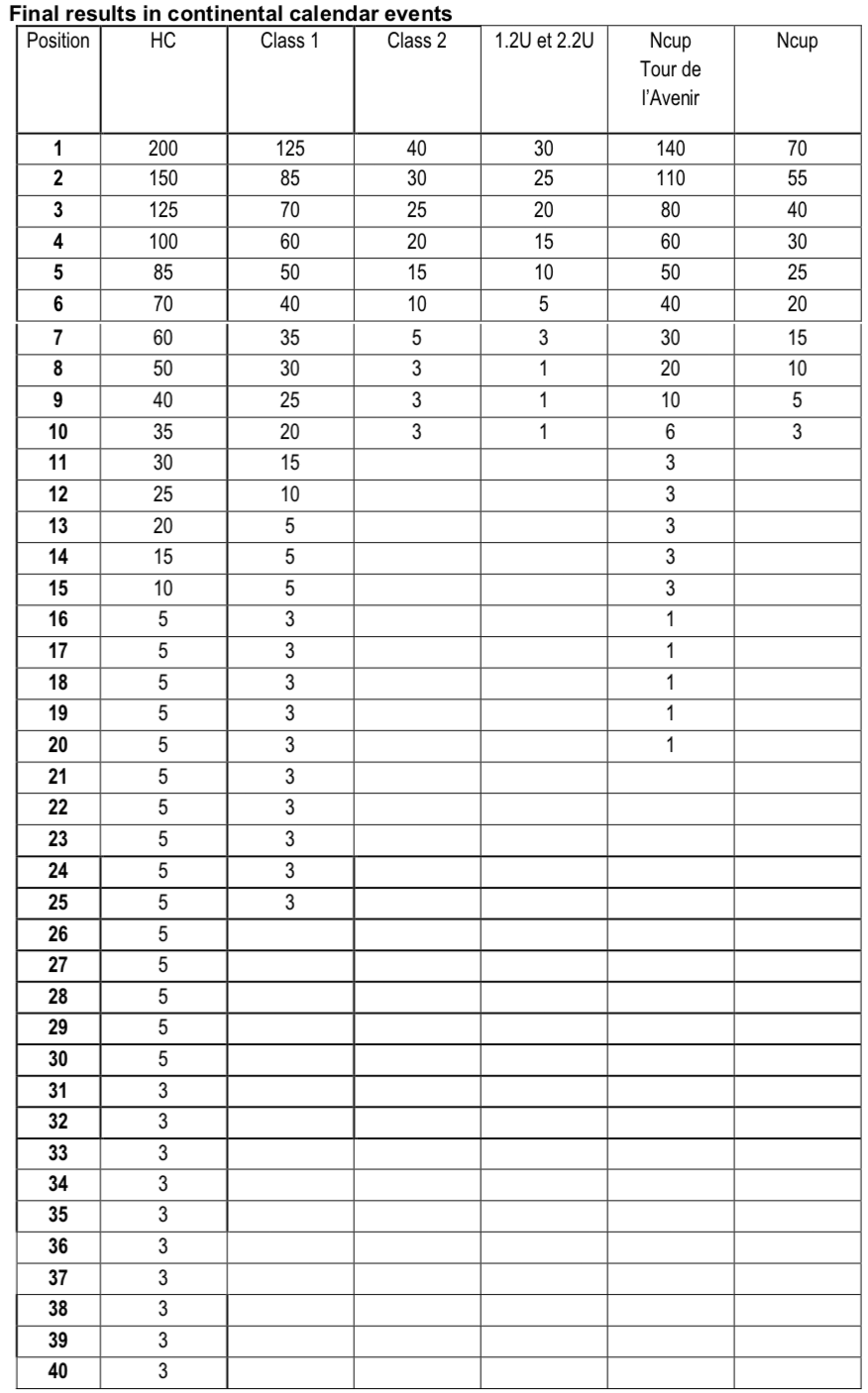


Next up is the table for the Continental Championships, for example the European Championships in Scotland in 2018 where Matteo Trentin won the men’s elite race. You make look on it as a bit of an odd event with a curious jersey but look and there’s 250 points for the winner which makes it valuable, enough to attract riders to take part but also as these continental confederations are part of the UCI’s structure, a way to ensure the UCI’s own events are valued too. And if there’s a team time trial then you can see the added table below too.
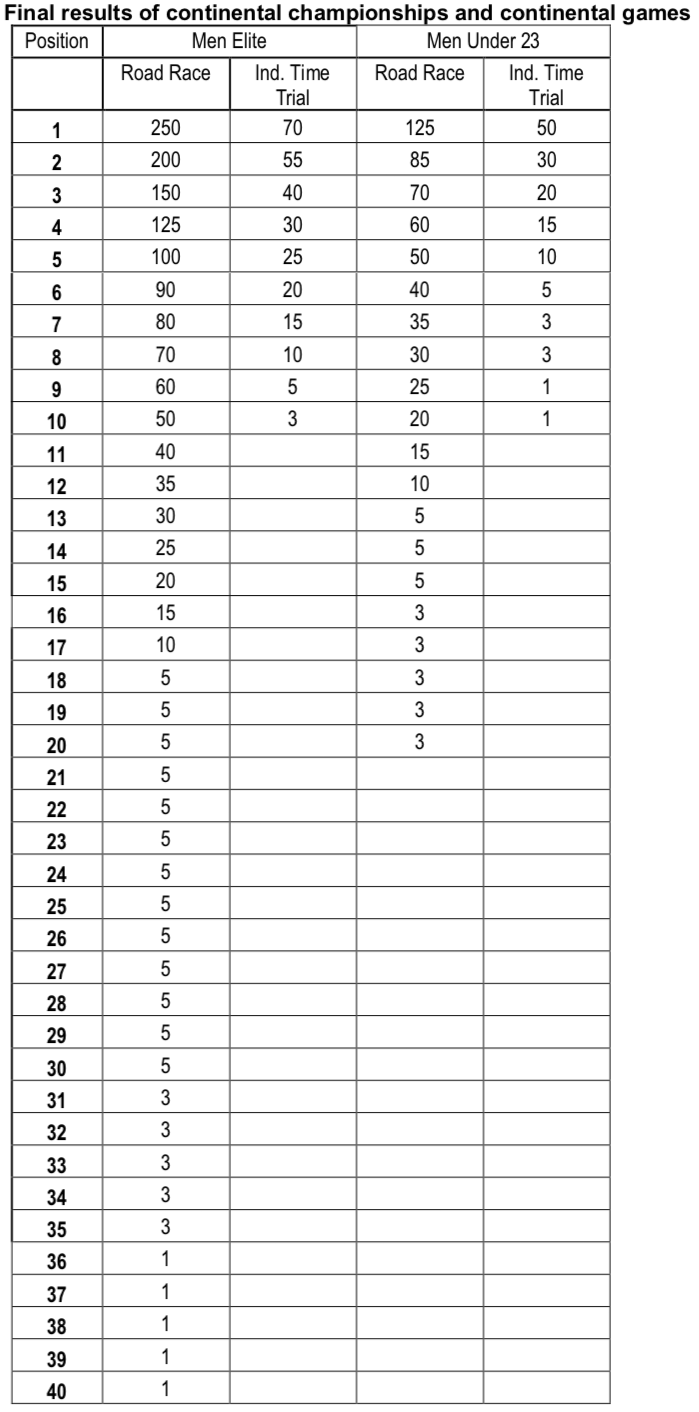
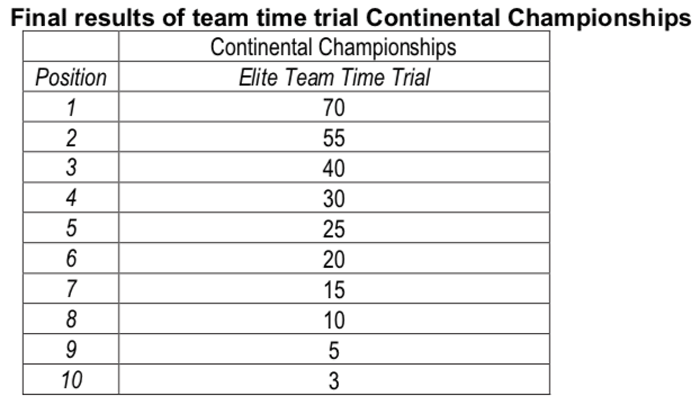
If the continental championships are related to the UCI’s structure, below is the table for the World Championships which is an event owned by the UCI, plus the Olympics on the road too. As you can see, the road race is valued at almost twice that of the time trial and with 600 points on offer the road worlds is the single most lucrative one day race on the calendar, a full 100 points than a Monument classic.
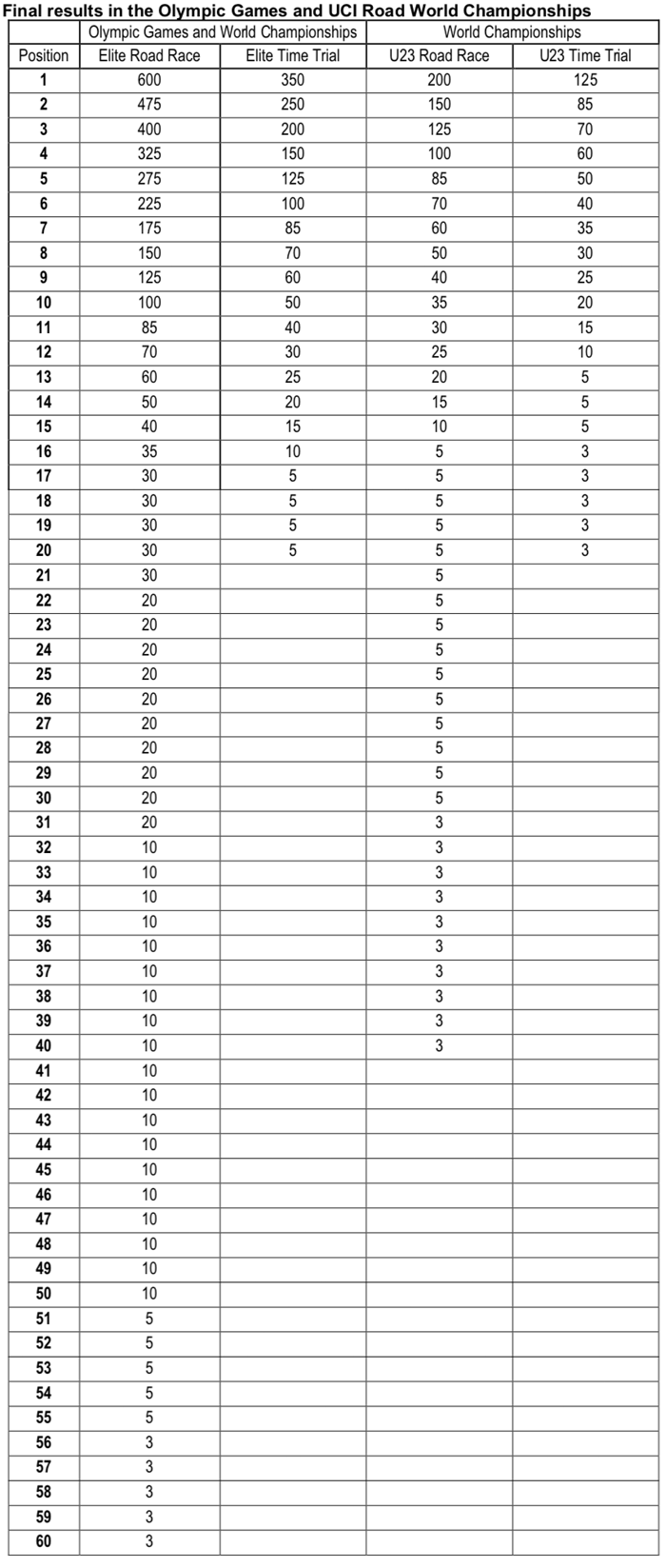
Lastly comes the new mixed relay time trial at the worlds. This event replaces the pro team time trial with a relay race ridden by a team of women and a team of men from each country and their combined time and the winners get 300 points each, whether they’re male or female and this raises the technical possibility of a good but not world beating men’s team getting 300 points each, more than second place in the solo TT event, because the women had a great ride (and vice versa).
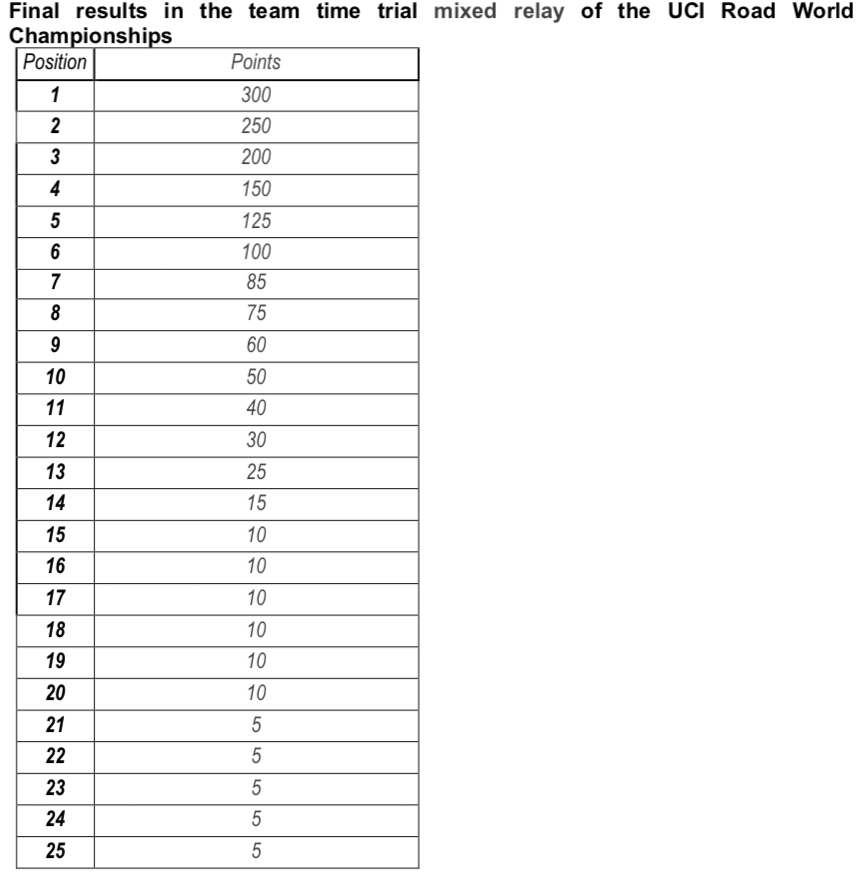
2020: You may not care too much for the rankings, you may question the relative importance attributed to different races but the UCI is going to issue 18 World Tour licences for 2020 which will last through until the end of 2022 and if the budget and admin are in order then “sporting criteria” will apply teams will be ranked by their UCI points haul. It won’t just those scored in the coming year but the 2018 and 2017 seasons too. Still for any squad that’s having a tough year they’ll be anxiously aiming for UCI points and deploying tactics to this end, perhaps trying place two riders in the top-10 in one of the Canadian one day races rather than going for broke with the win. As things stand Paddy Bevin’s stage win, spell in the Ochre jersey and a high finish on GC, possibly the win outright, are certainly something enormous for CCC to bank in January.
Conclusion
You may not care for the rankings but others do and they’re racing or behind the wheel of a team car. So the rankings maybe near meaningless to fans – perhaps they’re meant to be, you need to root around on the UCI website, find the right PDF, scroll to the right chapter – but they matter to the teams. Anyway, all the tables are listed above so if you want to look up the points scale in the future just click back here.

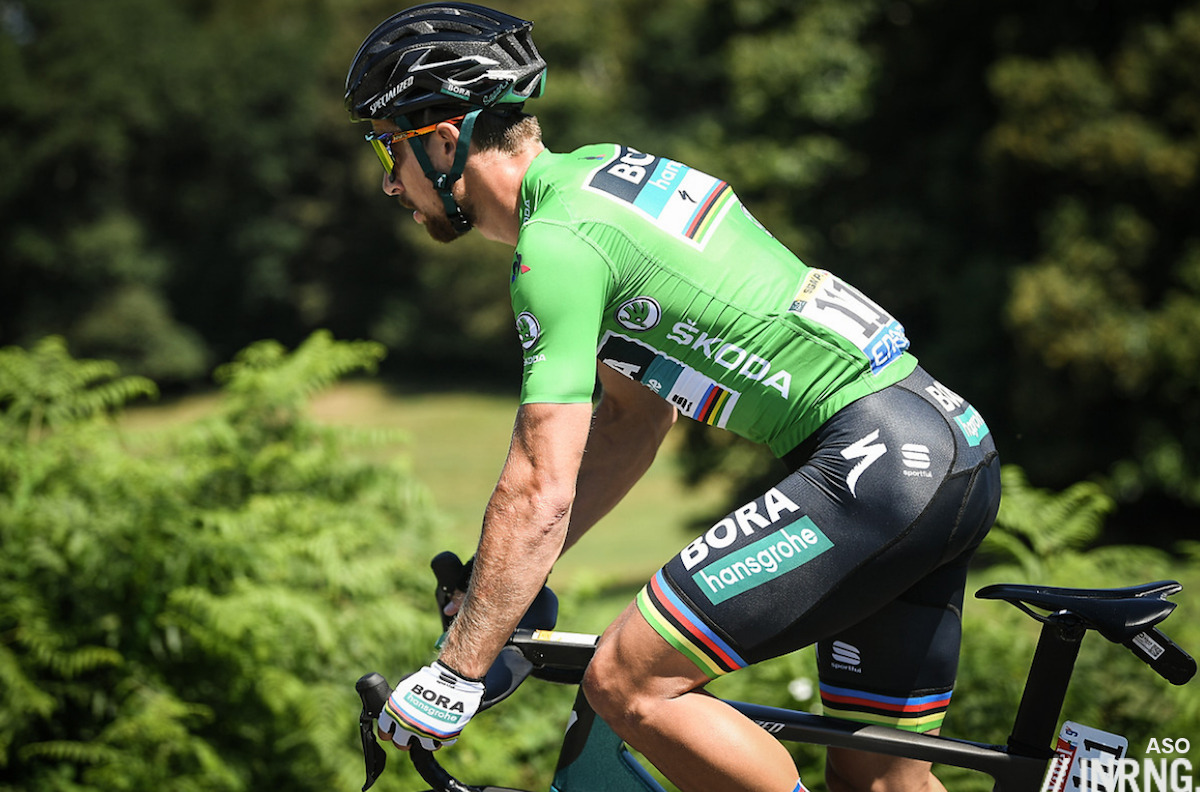
Thanks inrng. Looks like it was a lot of work to dig through pages of uci tables – hopefully this will make some team tactics clearer this year
A bit of manual labour to copy the tables that run across two pages into one but just useful for me because they’re now a click away for reference. I might include race previews with a mention of the points available too, not too romantic but a pointer to the tactics and incentives on the day.
Good idea.
To state that the winner of the Tour Down Under wins more points than 5th place at TdF does not tell the whole story though, given in the latter case a rider will most likely have picked up a multitude of additional points via the 21 x stages, so perhaps in fact it’s not the wholly unfair weighting it may first appear?
The same applies to the other Grand Tours.
Weighting the one day races is more problematic.
But, I’ve said it before and I’ll repeat it again, a win on a wet Wednesday at Huddersfield is 3 points, the same as a victory at Manchester Utd.
That’s how leagues work.
Pro cycling isn’t a league. It isn’t an all-play-all format. It’s not even close. What’s your point in that final comment?
It is a league though, isn’t it?
Any format that ranks its participants through a season by points is a league, the major flaw is that there’s not necessarily any prize for topping the ranking system.
And my final point is self-explanatory – for wet Wednesday in Huddersfield read searing Sunday on Willunga. 😀
GP Quebec and Montreal 500 1st place points……E3, Catalunya, Basque Country, La Flèche 400 1st place points….Strade 300 points….
Makes no sense (except to get riders to care/show for GP Quebec or Montreal)
If I were building my personal palmares I would take those races in inverse order. Screw the points.
The Australian and the Canadian races don’t belong in this category where they put them in. Period. It’s just a maketing thing. They don’t offer any thrill or surprises, all 3 races have just one playbook, year after year. It’s nice they exist, no doubt, but they just never will deserve the standing the UCI gave them, unless thre is some innovation someday.
Question – when a team wins 300 points for a TTT, who gets the points? If riders leave that team for another, do some points follow that rider?
Thank you for a rather interesting article! I bet some DMs are reading this!
Good question, I should add a bullet point above. To answer, for a TTT they go to the team but the points are divided among the participant riders, eg a Vuelta stage win is 100 points, if 8 riders win the team time trial then 100/8 = 12.5 points each.
As for leaving the team, then yes some points are held back. In the past this has been 20% but the 2020 version isn’t public and the system is rather complicated. If you have a cold towel handy and a spreadsheet then this blog post explains the system used so far: http://inrng.com/2013/04/uci-publish-sporting-criteria/
Thank you for the explanation. And I remember the 2013 column, I’m looking forward to understanding the new process. I think.
Am I right to assume that at the moment we are unable to make a temporary ranking of teams for awarding of 2020 WT spots?
I think it should be possible, I’ll have a go.
Actually, the new rules are quite clear about this. If a rider moves mid-season, then their pre-transfer points still count for their old team if they remain among its 10 top scorers. And their post-transfer points count for their new team if they make the top 10 of that team.
Theoretically, therefore someone like Sagan transferring after April could count for 2 teams: one with his Classics points, and the other with his stage race points.
The previous iteration of the rules worked this way too, even when it was only the top 5 riders being compared. Teams could compete on whichever was better of the points accrued by their current roster or their roster for the following year.
Had Cookson’s deal to save Dimension Data not gone through in 2016, Siutsou’s points would have counted for both DDD (his team at the time) and Bahrain-Merida (his team for the next year) when working out which team would get the last place.
That 3rd category’s the big problem for me: TdU, Paris-Nice, Tirreno, Dauphine, etc. with the same value as winning a Monument? NFW! There needs to be some separation there for sure.
Meanwhile, will we see a repeat of 17 teams fighting over 18 places again in 2020? But at least the UCI’s stepping over WADA to ban tramadol, so it’s not all bad!
At least 20 teams were interested in the 18 places on offer for 2019 with the extra two being denied by the ‘closed shop’ deal done to benefit Dimension Data a couple of years back, so I don’t see a problem for next year either.
Dave – refresh my faulty memory as to the names of the 2 teams denied for 2019 by the “closed shop” deal you describe. How long ago was it that we saw “17 teams fighting for 18 places”?
I’ll end with my age-old question of why the sport needs “Heinie’s Folly” in the first place? Nobody has offered a reasonable explanation as to how it does anything to improve the sport. I understand how it might improve various business aspects, but I don’t much care about those.
Direct Energie and Arkea-Samsic were both interested in applying for WT status if BMC didn’t make it.
Thanks but aren’t both of those teams, er…well….French? As such quite likely to get invites to Le Grand Boucle without joining the top club…like Cofidis?
If those are the best examples you’ve got I’d still contend we’re not far away from 17 teams fighting over 18 places in “Heinie’s Folly”.
Sorry, but that’s still no closer to being true than when you first started repeating that drivel.
If the group linked to Shane Sutton gets their finances together you’d be looking at 21 interested teams, possibly 22 if Marc Biven has another go. The new structure providing a clear path to WT status might also awaken interest from other Pro Continental teams which haven’t announced any intentions so far.
I think the real issue here is your jealousy – that other teams are making it work while Italian teams are unrepresented at the top level thanks to alienating every single potential major backer in the country with their relentless parade of scandals.
Sorry! Don’t get all RonDe on me, OK? My dislike of Heinie’s Folly has nothing to do with the (sad) state of Italian cycling or any sort of jealousy. I’ve complained about it long (and loudly) enough that my issues with it should be plain to all by now.
Trying to disprove my claims about this folly and paint a picture of many teams lined up to get into the top-tier by citing dreams of Shane Sutton and Marc Biver is a big stretch, should we add Tim Kay and Fernando Alonso into your fantasy while we’re at it?
Verbruggen is dead and my hope (and I’m still waiting for the proponents to explain how it improves the sport in the 1st place) is his pipe dream will RIP soon as well.
Have to say I agree with Larry about Heinie’s Folly! (without any jealousy of non-Italian teams!) Pity we can’t offer a differing opinion without describing others’ comments as ‘drivel’, too.
I agree with everything D Evans said.
Excellent piece – very interesting reading, thanks.
I’ve nothing very positive to say about the points system, though. I think the races are better as separate entities – but then I get to view them that way in my head anyway. There’s a minor interest in watching a team trying to put two riders into the top ten in Lombardia, but wouldn’t most rather watch them all trying to win it?
Having said that, if you want a promotion/relegation system (not sure that they’ll ever have enough teams for this to be an issue – nor if all Pro-conti [or whatever they’re now called] teams will want such an expensive promotion) then you have to have a points system of some kind. I’m unconvinced that it’s a system that is desirable. Then again, I could say the same for the whole WorldTour idea.
Is this new system likely to lead to what happened with the old system where riders were purchased for their ‘points value’ by teams who needed to boost their score – or have the UCI figured out a way to stop teams gaming the system?
I’ve always thought that a points system is unfair on the lowly domestique who works hard for others to gain points, but then sees his own financial value lessened relative to those with points when it comes to a new contract.
I think the present system does deal with the domestiques reasonably fairly.
When comparing the sporting criteria, each team is compared on the combined total of only its five best riders. Once you’ve got a handful of riders who can score well, the rest can be hired on what they contribute to the team and not on the points they score.
But at the end of the day, it’s simply too complicated. Better off to abolish all forms of adding together individual riders’ point tallies and simply score the teams on the results they achieve as a team, regardless of which riders are transferring. Give each team only their best result of each stage/race (i.e. doms should be allowed to go 100% for their leader without any need to sprint for 30th place) and promote/relegate one team each way at the end of every season.
I was about to suggest a similar idea: have the points only apply to teams.
That way, the system can’t be gamed by riders taking their points to other teams. Plus, it would mean that riders were judged solely on their merits.
Do that and a rider who scores regularly doesn’t get the value, their team owner does. It’s like being great at your job only to see your boss get promoted. Also if a team has a great year but loses all its best riders and ends up with a roster of weak riders then it can squat in the World Tour, indeed it can game this situation, dumping good riders once a three year licence is secure.
There’s no right or wrong to this all, just a lot of incentives beyond winning races outright, which is why it was probably worth putting all the points tables in one easy place.
Points can’t be taken away from a team under the current system, this was fixed a few years ago.
When comparing their totals for the sporting criteria, teams get to use whichever is better of their roster for the season just completed or their roster for the season about to start.
Until the plan to reduce the number of WT teams was scrapped, this resulted in Kanstantsin Siutsou’s points counting for two different teams fighting for the same WT position at the end of the 2016 season. He was one of Dimension Data’s best five riders from 2016 (and their 2016 roster being better than their 2017 roster) and also one of the best five riders signed by new team Bahrain-Merida for the 2017 season.
Simply comparing team results would have the effect of switching the sporting criteria from selecting the teams with the best lineups to selecting the teams with the best results as a team. The criticism of this is that teams can go from one good year to a bad year straight afterwards and so there’s always some level of ‘lag’ in the selection process. However, the same also applies to individual riders.
Good points both.
I think a rider’s value can be judged by the team who are wishing to employ him – so they don’t need points allocated to them.
However, Inner Ring’s ‘squatting’ point would be a definite issue.
The ‘lag’ issue that DaveRides mentions could be improved by having one year licences. Of course, the downside of that would be that if a team has one particularly bad year they’re unduly punished – so there would be a lack of stability.
No easy answers.
Even the ‘just get rid of the points/WorldTour’ solution doesn’t allow 2nd tier teams a way of entering the 1st tier – although if individual races just decided which teams they had in their races it would probably end up being pretty fair overall. I think that would be my choice – get rid of the tiers and there is no promotion/relegation or points or a league system.
Not the biggest issue in the sport, but an interesting one to delve into the details of.
Most team sports with promotion/relegation do it every year.
The instability could be mitigated by having a two-step relegation before a team goes all the way to missing out completely. A team in category WT1 would get relegated to WT2 for one year before being relegated to PT if their poor performance persisted, which would give generally good teams which have one bad year (e.g. Giant-Alpecin after that training crash took out Degenkolb and others) the safety net of a year to return to normal performance.
This is not an issue to be ignored just because it isn’t the biggest one, because it does have an impact on the capacity of sponsors to invest in the sport and work their way in.
Persisting with the current ‘closed shop’ system (introduced by Brian Cookson to protect Dimension Data) is not an option, because the current system certainly does enable the squatting teams.
Question – is the awarding of points for the points and mountain jerseys in GTs new this year? I ask because my go-to source for race results is the procyclingstats.com website, and I have never seen any UCI points listed for those jerseys. That has always seemed odd to me, since those jerseys are highly valued, and those races-within-the race tend to enliven the early weeks of the GTs substantially.
Thanks for the summary! And I could make that last comment after almost every one of your posts, but don’t want to be too repetitive. Keep up the great work.
It is perhaps necessary to throw into the conversation the teams “value” equation. The fact that sponsors many times have geo specific marketing goals! Which may in some instances cause a teams management to have to forego higher points races and throw more valuable resources (riders) at less points value races to keep sponsors satisfied.
How is Basque Country worth less than Romandie? In my book it’s completely the opposite!
Am I reading correctly that no points are awarded for a yellow jersey wearer at each stage (but 5 points for a leader’s jersey wearer each day in HC event)? A bit harsh.
No, the daily leader’s jersey points for WT races are in a different table slightly higher up the page.
Noted, thank you!
What roughly determines the difficulty of a race and therefore how impressive it is to win are the riders there. It can be a self-fulfilling prophecy like Gent-Wevelgem, a race of prestige because good riders race it (because it has prestige). But so the quality of riders at a race is a good proxy for how prestigious/impressive it is to win it. As an alternative ranking system, what about taking people’s positions in the previous year of UCI points and awarding points for races based on the quality of riders. The first year relies on this current system, which has its flaws, but from there it would get recursively better and more accurate. One might need a separate sprinters, climber, escapee form of ranking of riders to distinguish a tough sprint between an equally high ranking Porte and Caleb Ewan. Not a perfect system but a good proxy for what the rankings are trying to achieve perhaps.
You’d end up with something like the PCS ranking of races (see link in name), which itself has a couple of anomalies, not least Paris-Roubaix being so low (probably cause of its specialist nature and the Giro being low too (perhaps because all the better sprinters are building to the Tour?)
Ranking points can seem quite silly, but I just had an enjoyable half hour “spending” 900 points on my ideal imaginary career palmarès
Angus, I too burned more time than I should doing the same thing. Unfortunately, my cumulative career points would be rather low as I favor the hard man one day tilts or the crazy one week Spanish/Basque stage races which dwell in buckets 3-5. March through April – best racing of the year.